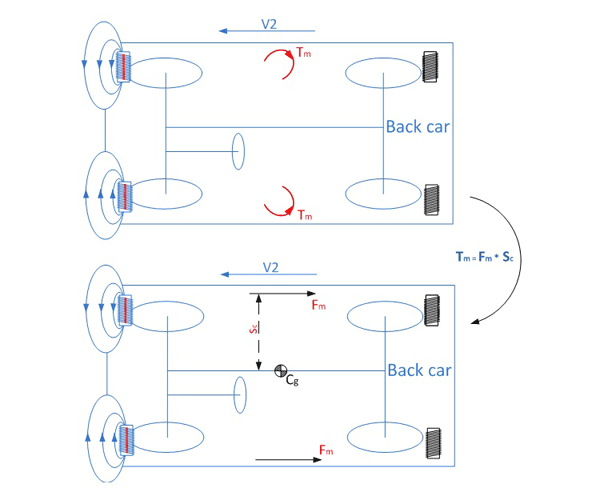Electromagnetic Safety System
by Chen Chen, Clemson Automotive Engineering Graduate Student
- Basic Description
-
Vehicle safety is always one of the most important issues on vehicles. From the birth of vehicles, a lot of systems have been integrated into this great invention, both in mechanical devices and electronic systems. For example, tower bars and anti-roll bars can significantly enhance vehicle's stability in the corner; while front rail and firewalls can definitely mitigate the injury of cars and passengers during the crash. The changing from retractable headlights to fixed ones on Mazda MX5 is also based on the safety to pedestrians. Anti-lock braking system has been the standard equipment on every vehicle for a long time. Adaptive cruise control, blind spot detection and lane departure warning are all new systems to increase vehicle safety. However, even though these electronic systems exist, some crashes still happen. A study conducted by the German Association of Insurance revealed that 50% of rear-end collisions occur without any braking and as much 70% percent occur with braking that is insufficient to stop the vehicle in time. That means, when two cars come very close, although drivers have used full brake, the brake force is not enough to avoid accidents, because the maximum braking force is the ground contact force, which is limited to normal load and adhesive coefficient. In this situation, the EMSS can provide additional force to increase vehicle's deceleration, minimizing the damage caused by accidents.
This system is based on magnetic field. As we know, variable current in solenoid can generate magnetic field. The intensity is directly proportional to change rate of current in the solenoid. When this system is activated, it means the crash is coming and the safety grade of this vehicle is upgraded to the top one. All systems relative to safety should be in high priority and all electricity in the battery should be transformed to the solenoids, except for other safety systems, such as ABS, airbags, brakes, etc. When large current variable happens in solenoid, big magnetic field will generate, which is the same as the end of the front car. Then, two big magnetic fields will form strong magnetic force to prevent the accident.

A Simplified Diagram of an Electromagnetic Safety System
- Principle and Control Strategy
-
The control strategy should be very strict. First, there are two trigger condition; either one can activate this system. The first one is a little same as the one in Automatic Braking Systems. When the distance between two cars is less than D0 and the speed difference is larger than V0, ECU creates a signal to give first priority to safety and this EMSS will be activated. The other condition is based on Dedicated Short Range Communications (DSRC). Because the systems of two cars must work at the same time, otherwise the magnetic field will attract the other car, which is extremely terrible; the system of the front car must be activated by the back car. When the back car detect the crash is "unavoidable", it sends a signal to the front car via DSRC; then the front car "knows" another car is going to "hit" it and the front car creates a signal to give second priority (not the same as the back car, because in rear-end collisions, the damage of front car is not as severe as the back car, what it should do is to activate the system to generate a magnetic field) to safety. After that, the two systems of two cars begin to work at the same time. The big magnetic force will help to increase back vehicle's deceleration and mitigate the damage.
Torque analysis and equivalent force
 |
The design of two solenoids is based on the effect of magnetic force. The interaction is to generate a torque to rotate the solenoid, in order to make two magnetic fields in the same direction. This will make vehicles yaw, which is very harmful. Actually two solenoids will cause the force balance in the lateral direction. When either vehicle comes to a stop, or the distance is in safe range, or the electricity devices fail during the collision, EMSS will be deactivated and the magnetic field will disappear. The same as the activating process, this deactivating process should be working at the same time for these two vehicles.

Control flow chart of an Electromagnetic Safety System
- Sensors
- vehicle speed sensor, headway sensor (radar or lidar)
- Actuators
- solenoid
- Data Communications
- DSRC; Control Unit Communication: Typically Control Area Network (CAN) Bus System
- For More Information
- [1] Magnetic field, Wikipedia.
- [2] Helmholtz coil, Wikipedia.
- [3] Passive Safety Technologies, Notes From the Road, the Editors/autoMedia.com
- [4] Automatic Braking Systems, CVEL website.
|

